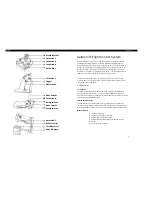
AvL Proprietary and Confidential
Content is Subject to Change without Notice
Page
168
of
195
The popularity of satellite services using inclined geosynchronous satellites is growing and becoming
a more frequent exception to the stationary rule. These satellites typically start their service lives in
stationary orbits. As their station keeping fuel supply dwindles, the satellite operator decides to
extend the life of the satellite by moving the satellite into an inclined orbit that requires much less
fuel to maintain.
The new orbit is still geosynchronous (orbit period = 1 day), but the satellite no longer appears
stationary when viewed from the Earth’s surface. Instead, it moves in a predictable, narrow “figure
8” path that aligns North to South. The price charged for bandwidth on these inclined / drifting
satellites is much lower than that charged for stationary satellites, hence their growing popularity.
The AAQ may be optionally configured with satellite tracking capabilities through the addition of
software modules. Two tracking modes are currently available, with more to follow. They are Step
Track and TLE Track.
7.4.14 Step Track
Step Track mode is designed to address the first exception to the stationary satellite rule described
above. It is also very useful when an AvL transportable antenna might be inadvertently deployed on
an unstable surface, such as sand or loose soil. Any gradual, permanent changes in antenna pointing
due to the frequent vibration of passing vehicles or induced by gusty winds on the antenna’s
reflector are automatically corrected.
Step Track is best described as periodic Fine Peaking of the antenna system. The periodic peaking
process is the same as described in Section 7.4.10. Small step scans are performed in Ped-AZ and
Ped-EL until the Fine Peaking criteria is met. The AAQ then waits a specified time period (Level 4
user settable) and repeats the process. This method insures that the antenna beam remains peaked
on the target satellite and temporary antenna gain loss due to “step off” is minimized by choosing
an appropriately small angular step size, which is also Level 4 user settable. See appendix M for the
Step Track option.
7.4.15
Two-Line Element (TLE) Track
TLE Track mode is the preferred approach for tracking inclined geosynchronous satellites. As
mentioned above, the track that these satellites make in the sky is predictable and a standard
method for efficiently and accurately calculating the time varying antenna pointing solution has
been developed. This standard method uses a set of orbital elements in a standard format called
Two-Line Elements (TLE) that describe the orbit of Earth-orbiting satellites. These TLE sets are
widely distributed on the Internet. A computer program called a model or propagator uses the TLE
set to calculate the pointing solution for the target satellite at a particular time.
















































